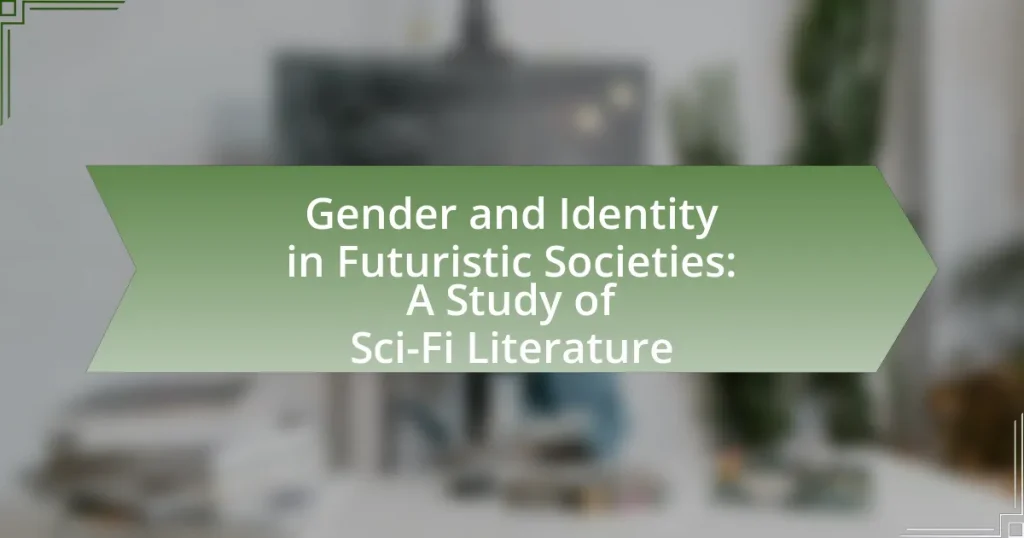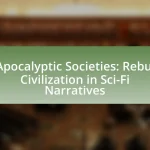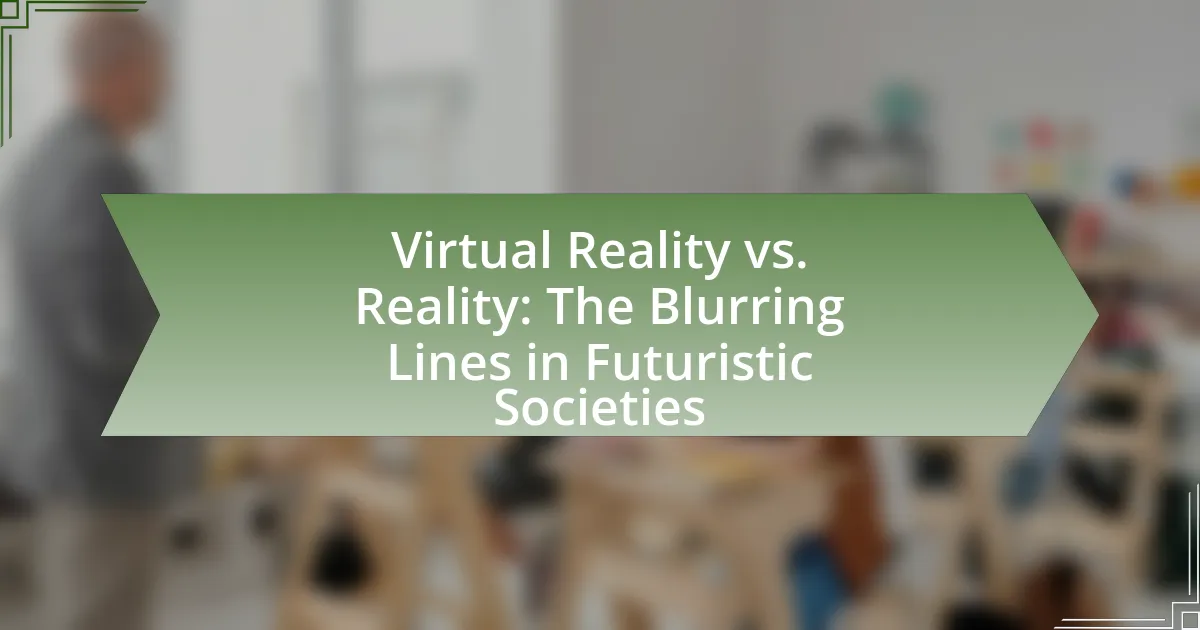The article examines the themes of gender and identity in futuristic societies as depicted in sci-fi literature. It highlights the fluidity of gender roles, the impact of technology on identity, and the exploration of societal norms through various authors’ perspectives. Key discussions include the representation of gender roles, the influence of societal structures and governance on identity, and the intersectionality of class and race. The article also addresses historical contexts that shape contemporary narratives and the implications of these themes for future societal understandings of gender and identity.
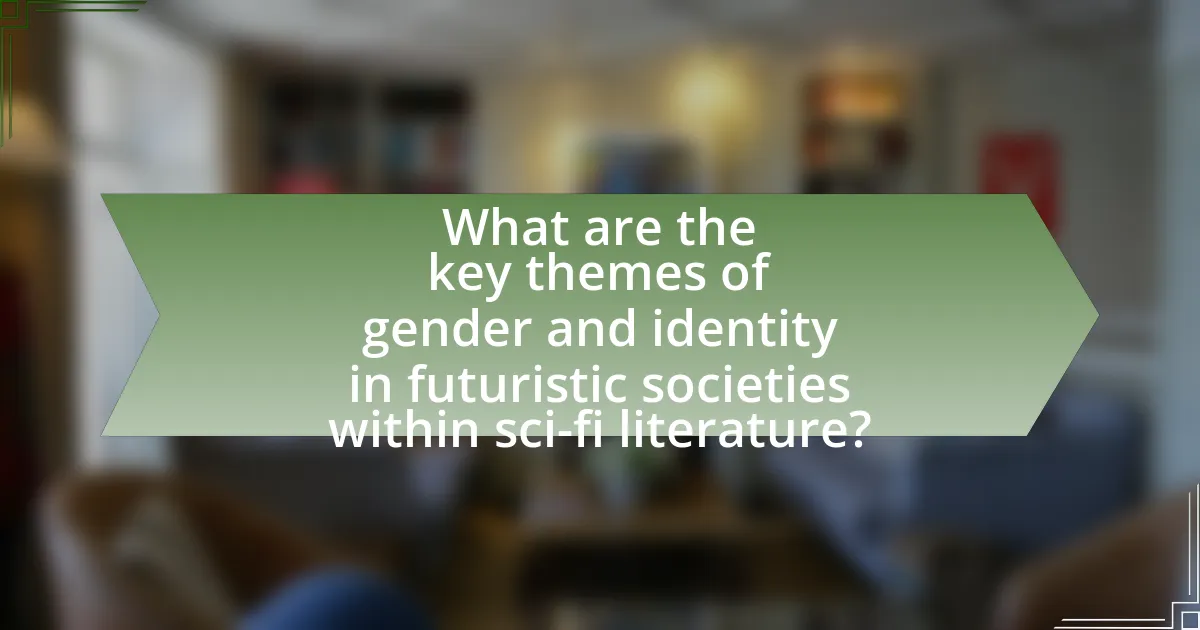
What are the key themes of gender and identity in futuristic societies within sci-fi literature?
Key themes of gender and identity in futuristic societies within sci-fi literature include the fluidity of gender roles, the impact of technology on identity, and the exploration of societal norms. Sci-fi narratives often depict characters who transcend traditional gender binaries, reflecting a more inclusive understanding of gender. For instance, works like “The Left Hand of Darkness” by Ursula K. Le Guin illustrate a society where gender is not fixed, challenging readers to reconsider their perceptions of identity. Additionally, the integration of advanced technologies, such as artificial intelligence and genetic engineering, raises questions about what it means to be human and how identity can be constructed or altered. These themes are prevalent in various texts, showcasing the evolving nature of gender and identity in speculative futures.
How do different sci-fi authors approach the concept of gender?
Different sci-fi authors approach the concept of gender by exploring diverse representations and challenging traditional norms. For instance, Ursula K. Le Guin in “The Left Hand of Darkness” presents a society where gender is fluid, allowing characters to change sex, which critiques binary gender roles. Similarly, Octavia Butler’s works, such as “Kindred,” examine the intersection of race and gender, highlighting how societal structures impact identity. In contrast, authors like Philip K. Dick often depict gender in relation to technology and identity, questioning the essence of humanity. These varied approaches reflect the authors’ intent to provoke thought about gender constructs and their implications in society.
What are the recurring gender roles depicted in these narratives?
Recurring gender roles in futuristic sci-fi narratives often depict women in nurturing, supportive roles while men are portrayed as dominant, action-oriented figures. For instance, female characters frequently embody traits associated with caregiving and emotional intelligence, often serving as moral compasses or stabilizing forces within the story. Conversely, male characters are typically depicted as leaders, warriors, or innovators, emphasizing strength and rationality. This pattern reflects traditional societal norms, where women are associated with domesticity and men with power and agency. Such portrayals can be observed in works like “The Handmaid’s Tale” by Margaret Atwood, where women are relegated to subservient roles, and “Dune” by Frank Herbert, which showcases male characters in positions of authority and control. These recurring themes highlight the persistence of gender stereotypes in speculative fiction, influencing perceptions of gender roles in contemporary society.
How do these roles challenge or reinforce traditional gender norms?
Roles in futuristic societies often challenge traditional gender norms by depicting characters who defy conventional expectations. For instance, female protagonists in sci-fi literature frequently take on leadership roles, showcasing strength and independence, which contrasts with historical portrayals of women as passive or subordinate. This shift is evident in works like “The Left Hand of Darkness” by Ursula K. Le Guin, where gender fluidity is explored, undermining binary gender roles and emphasizing the social construction of gender. Conversely, some narratives may reinforce traditional norms by portraying characters in stereotypical roles, such as women as caregivers or men as warriors, thus perpetuating existing societal expectations. Overall, the representation of gender roles in sci-fi literature serves as a reflection of and commentary on contemporary gender dynamics, either challenging or reinforcing traditional norms based on the narrative context.
What impact does technology have on gender identity in these societies?
Technology significantly influences gender identity in futuristic societies by enabling fluidity and diversity in gender expression. In many sci-fi narratives, advanced technologies such as virtual reality, genetic engineering, and artificial intelligence allow individuals to transcend traditional gender norms, facilitating the exploration of identities beyond binary classifications. For instance, in the novel “Altered Carbon” by Richard K. Morgan, characters can change their physical forms and gender through body-swapping technology, illustrating how technology can challenge and redefine societal perceptions of gender. This reflects a broader trend in contemporary discussions about gender identity, where technology serves as a tool for self-exploration and expression, ultimately reshaping societal norms and expectations surrounding gender.
How is gender fluidity represented through technological advancements?
Gender fluidity is represented through technological advancements by showcasing the ability to alter one’s physical form and identity in real-time, as seen in various sci-fi literature. For instance, in works like “Altered Carbon” by Richard K. Morgan, characters can transfer their consciousness into different bodies, allowing for fluid gender expression and identity. This narrative reflects contemporary discussions on gender fluidity, emphasizing the potential for technology to enable personal autonomy over one’s identity. Additionally, virtual reality platforms and social media allow individuals to present themselves in diverse gender expressions, further illustrating how technology facilitates the exploration and acceptance of gender fluidity in society.
What are the implications of artificial intelligence on gender identity?
Artificial intelligence significantly impacts gender identity by challenging traditional notions of gender and enabling fluidity in identity expression. AI technologies, such as virtual avatars and gender recognition systems, can create environments where individuals can explore and express diverse gender identities beyond binary classifications. For instance, AI-driven platforms allow users to select or modify their gender presentation, fostering a more inclusive understanding of gender. Research indicates that these technologies can enhance visibility for non-binary and transgender individuals, as seen in studies highlighting the role of social media algorithms in amplifying diverse gender narratives. Thus, AI not only influences personal identity formation but also shapes societal perceptions of gender, promoting a broader acceptance of varied identities.
How do societal structures influence gender and identity in sci-fi settings?
Societal structures significantly influence gender and identity in sci-fi settings by shaping the roles, expectations, and interactions of characters within those narratives. For instance, in works like Ursula K. Le Guin’s “The Left Hand of Darkness,” the absence of fixed gender roles in the planet Gethen challenges traditional notions of identity, illustrating how societal norms can dictate personal identity and relationships. Additionally, in “The Handmaid’s Tale” by Margaret Atwood, a dystopian society enforces rigid gender roles that strip women of autonomy, highlighting how oppressive structures can define and limit individual identities. These examples demonstrate that sci-fi often reflects and critiques real-world societal structures, revealing their profound impact on gender and identity.
What types of governance are depicted, and how do they affect gender roles?
The types of governance depicted in sci-fi literature often include authoritarian regimes, democratic systems, and technocratic societies, each significantly affecting gender roles. Authoritarian regimes typically enforce rigid gender norms, limiting women’s rights and opportunities, as seen in works like “The Handmaid’s Tale” by Margaret Atwood, where a theocratic government subjugates women. In contrast, democratic systems often promote gender equality, allowing for diverse representations and roles, as illustrated in “The Dispossessed” by Ursula K. Le Guin, where gender fluidity is embraced. Technocratic societies may prioritize efficiency over traditional gender roles, leading to more egalitarian structures, as seen in “The Moon is a Harsh Mistress” by Robert A. Heinlein, where women participate equally in the revolutionary efforts. These governance types shape societal expectations and individual identities, influencing how gender roles are constructed and perceived within these futuristic contexts.
How do class and race intersect with gender identity in these narratives?
Class and race intersect with gender identity in these narratives by shaping the experiences and societal roles of characters, often highlighting systemic inequalities. In many sci-fi stories, characters from marginalized racial backgrounds face compounded challenges due to both their race and gender, which can limit their opportunities and influence their identities. For example, in Octavia Butler’s “Kindred,” the protagonist’s experience as a Black woman in different historical contexts illustrates how race and gender intersect to create unique struggles against oppression. Additionally, studies show that narratives often reflect real-world disparities, such as the 2019 report by the American Psychological Association, which indicates that women of color experience higher rates of discrimination and economic disadvantage, further emphasizing the intersectionality of class, race, and gender identity in literature.
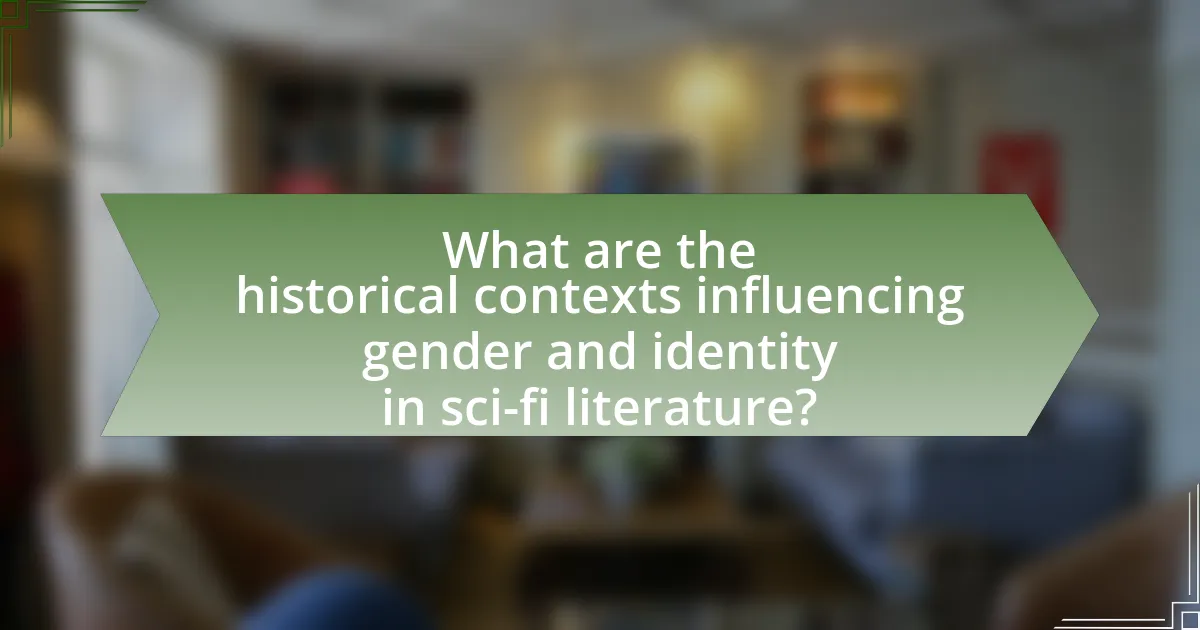
What are the historical contexts influencing gender and identity in sci-fi literature?
Historical contexts influencing gender and identity in sci-fi literature include the feminist movements of the 1960s and 1970s, which challenged traditional gender roles and inspired authors to explore alternative identities and societal structures. The emergence of LGBTQ+ rights movements in the late 20th century further expanded the representation of diverse sexual and gender identities in science fiction narratives. Additionally, the Cold War era’s anxieties about technology and societal change prompted authors to examine the implications of gender and identity in dystopian and utopian settings. These historical movements and events shaped the themes and characterizations in sci-fi literature, reflecting broader societal shifts and the quest for equality and representation.
How have past societal norms shaped contemporary sci-fi narratives?
Past societal norms have significantly influenced contemporary sci-fi narratives by embedding themes of gender roles, identity, and social structures reflective of historical contexts. For instance, early sci-fi often mirrored the patriarchal values of the time, portraying male protagonists as dominant figures while relegating female characters to secondary roles. This trend can be seen in works like Isaac Asimov’s “Foundation” series, where male characters drive the plot, reflecting mid-20th century gender dynamics.
In contrast, contemporary sci-fi increasingly challenges these norms, showcasing diverse identities and complex gender representations. Works such as N.K. Jemisin’s “The Fifth Season” illustrate this shift by presenting a world where societal hierarchies based on race and gender are critically examined, reflecting modern discussions on intersectionality. This evolution in narrative structure and character development demonstrates how past societal norms have shaped the genre, pushing it towards more inclusive and varied representations that resonate with current social movements.
What historical events are reflected in the portrayal of gender in these works?
The portrayal of gender in futuristic sci-fi literature reflects significant historical events such as the women’s suffrage movement, the feminist movements of the 1960s and 1970s, and the LGBTQ+ rights movement. These events have shaped societal views on gender roles and identity, influencing authors to explore themes of equality, empowerment, and the deconstruction of traditional gender norms. For instance, works like “The Left Hand of Darkness” by Ursula K. Le Guin, published in 1969, challenge binary gender constructs, mirroring the era’s push for gender equality and the questioning of established norms. Similarly, the representation of diverse gender identities in contemporary sci-fi reflects ongoing discussions about gender fluidity and inclusivity, rooted in the historical context of the LGBTQ+ rights movement.
How do authors use historical context to critique modern gender issues?
Authors use historical context to critique modern gender issues by drawing parallels between past societal norms and contemporary gender dynamics. For instance, in works like Margaret Atwood’s “The Handmaid’s Tale,” the author references historical events such as the Puritanical repression of women to highlight ongoing issues of autonomy and reproductive rights. This historical lens allows readers to see the cyclical nature of gender oppression, emphasizing that many modern struggles are not new but rather echoes of past injustices. By situating current gender debates within a historical framework, authors effectively illustrate how entrenched societal attitudes continue to shape and influence contemporary gender issues.
What role does feminism play in the evolution of gender representation in sci-fi?
Feminism plays a crucial role in the evolution of gender representation in sci-fi by challenging traditional gender norms and advocating for diverse portrayals of women. This movement has led to the emergence of strong female characters and narratives that explore gender dynamics, as seen in works by authors like Ursula K. Le Guin and Octavia Butler, who incorporate feminist themes to critique societal structures. For instance, Le Guin’s “The Left Hand of Darkness” examines gender fluidity, while Butler’s “Kindred” addresses race and gender intersectionality. These contributions have significantly influenced the genre, promoting a broader understanding of gender and identity in futuristic societies.
How have feminist movements influenced sci-fi literature over time?
Feminist movements have significantly influenced sci-fi literature by introducing themes of gender equality, challenging traditional gender roles, and promoting female agency. Starting in the 1960s, the second-wave feminist movement inspired authors like Ursula K. Le Guin and Octavia Butler to explore complex female characters and societal structures that question patriarchal norms. Works such as Le Guin’s “The Left Hand of Darkness” and Butler’s “Kindred” not only depict women in diverse roles but also critique the gender binary, reflecting the feminist discourse of their time. This influence has continued into contemporary sci-fi, where authors like Nnedi Okorafor and Ann Leckie further expand on these themes, showcasing the evolution of gender identity and intersectionality in futuristic narratives. The ongoing dialogue between feminist movements and sci-fi literature illustrates how societal changes shape literary expression and vice versa.
What are some notable feminist sci-fi works that challenge gender norms?
Notable feminist sci-fi works that challenge gender norms include “The Left Hand of Darkness” by Ursula K. Le Guin, which explores a society where gender is fluid, and “Kindred” by Octavia Butler, which examines the intersection of race and gender through time travel. Additionally, “The Dispossessed” by Le Guin presents a dual society with contrasting gender roles, while “Parable of the Sower” by Butler addresses themes of survival and gender in a dystopian future. These works are significant for their critical examination of traditional gender roles and their impact on society.
How do cultural perspectives shape the understanding of gender in sci-fi?
Cultural perspectives significantly shape the understanding of gender in sci-fi by influencing the portrayal of gender roles, identities, and relationships within futuristic narratives. For instance, Western sci-fi often reflects traditional gender binaries and patriarchal structures, as seen in works like Isaac Asimov’s “Foundation” series, where male characters dominate leadership roles. In contrast, feminist sci-fi, such as Octavia Butler’s “Kindred,” challenges these norms by presenting complex female protagonists who navigate and subvert societal expectations. Additionally, non-Western sci-fi, like Liu Cixin’s “The Three-Body Problem,” introduces alternative gender constructs influenced by cultural contexts, thereby expanding the discourse on gender beyond Western paradigms. This diversity in representation highlights how cultural backgrounds inform the conceptualization of gender, ultimately enriching the genre and prompting critical discussions about identity and societal norms.
What are the differences in gender representation across various cultures in sci-fi literature?
Gender representation in sci-fi literature varies significantly across cultures, reflecting societal norms and values. For instance, Western sci-fi often portrays women in roles that challenge traditional gender norms, such as strong female protagonists in works like “The Hunger Games” by Suzanne Collins. In contrast, Japanese sci-fi, exemplified by works like “Ghost in the Shell” by Masamune Shirow, frequently features female characters who embody both empowerment and objectification, highlighting complex gender dynamics. Additionally, African sci-fi, as seen in Nnedi Okorafor’s “Binti,” often emphasizes matriarchal themes and the strength of female characters within communal contexts. These differences illustrate how cultural backgrounds shape the portrayal of gender, with each culture offering unique perspectives on identity and societal roles in futuristic settings.
How do cultural narratives influence the portrayal of identity in futuristic societies?
Cultural narratives significantly shape the portrayal of identity in futuristic societies by establishing frameworks through which individuals understand themselves and their roles within these imagined worlds. These narratives often reflect contemporary societal values, fears, and aspirations, influencing how gender, race, and class are represented. For instance, in works like “The Left Hand of Darkness” by Ursula K. Le Guin, the narrative challenges traditional gender binaries by depicting a society where individuals can change their gender, thereby prompting readers to reconsider their own perceptions of identity. This illustrates how cultural narratives can redefine identity constructs, making them fluid and multifaceted in futuristic contexts.
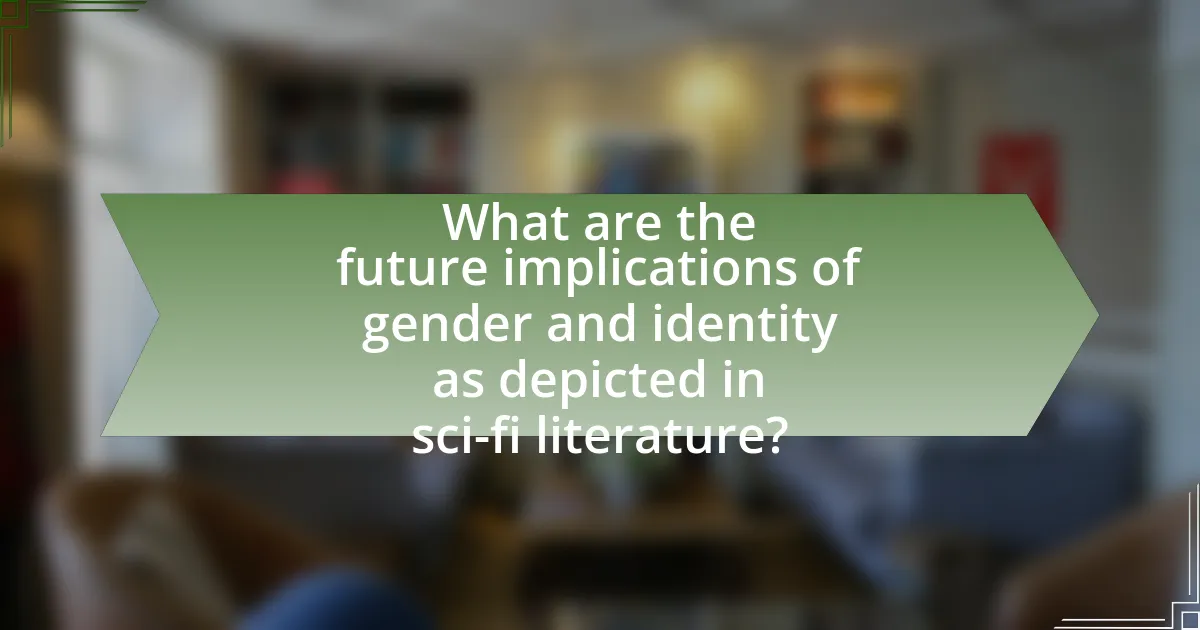
What are the future implications of gender and identity as depicted in sci-fi literature?
The future implications of gender and identity as depicted in sci-fi literature suggest a transformative landscape where traditional binaries may dissolve, leading to more fluid and diverse representations of identity. Sci-fi narratives often explore advanced technologies, such as genetic engineering and artificial intelligence, which can challenge and redefine human experiences of gender. For instance, works like “The Left Hand of Darkness” by Ursula K. Le Guin illustrate societies where gender is not fixed, prompting readers to reconsider the social constructs surrounding identity. This exploration can influence real-world discussions on gender fluidity and inclusivity, as seen in contemporary movements advocating for non-binary recognition and rights. Thus, sci-fi literature serves as both a reflection and a catalyst for evolving understandings of gender and identity in future societies.
How might current trends in gender identity evolve in future societies?
Current trends in gender identity may evolve towards greater fluidity and inclusivity in future societies. As societal norms continue to shift, the understanding of gender is likely to expand beyond the binary framework, reflecting a spectrum of identities. Research indicates that younger generations increasingly identify as non-binary or genderqueer, suggesting a cultural move towards acceptance of diverse gender expressions. For instance, a 2021 study by the Williams Institute found that 1.2 million adults in the U.S. identify as non-binary, highlighting a significant demographic shift. This evolution may lead to legal and institutional changes, such as the implementation of gender-neutral policies and the recognition of multiple gender identities in official documents.
What predictions do authors make about the future of gender roles?
Authors predict that future gender roles will become increasingly fluid and less defined by traditional binaries. This shift is anticipated due to the growing influence of technology, social movements, and changing cultural norms that challenge conventional gender identities. For instance, in works like “The Left Hand of Darkness” by Ursula K. Le Guin, the exploration of a society where gender is not fixed illustrates the potential for diverse expressions of identity. Additionally, research indicates that as societies evolve, there is a trend towards greater acceptance of non-binary and genderqueer identities, suggesting a move away from rigid classifications. This evolution reflects broader societal changes and the impact of feminist and LGBTQ+ activism, which advocate for more inclusive understandings of gender.
How do these predictions reflect contemporary societal changes?
Predictions in sci-fi literature about gender and identity reflect contemporary societal changes by illustrating evolving norms and values surrounding these concepts. For instance, many recent works depict fluid gender identities and challenge traditional binaries, mirroring real-world movements advocating for LGBTQ+ rights and gender inclusivity. A notable example is the novel “The Left Hand of Darkness” by Ursula K. Le Guin, which explores a society where gender is not fixed, paralleling current discussions on gender fluidity and non-binary identities. This alignment between fiction and societal shifts highlights how speculative narratives can serve as a lens through which to examine and critique ongoing changes in gender and identity politics.
What lessons can be learned from sci-fi literature regarding gender and identity?
Sci-fi literature teaches that gender and identity are fluid concepts shaped by societal norms and technological advancements. Works like Ursula K. Le Guin’s “The Left Hand of Darkness” illustrate how gender can be perceived differently in a society where individuals can change their gender, challenging binary notions and emphasizing the social construction of identity. Additionally, Octavia Butler’s “Kindred” explores the intersection of race and gender, highlighting how historical contexts influence identity formation. These narratives encourage readers to question traditional gender roles and consider the impact of culture and technology on personal identity.
How can these narratives inform real-world discussions on gender issues?
Narratives in sci-fi literature can inform real-world discussions on gender issues by providing imaginative frameworks that challenge traditional gender norms and explore diverse identities. For instance, works like “The Left Hand of Darkness” by Ursula K. Le Guin present societies where gender is fluid, prompting readers to reconsider binary classifications and the implications of gender roles. This can lead to critical dialogues about inclusivity and representation in contemporary society, as evidenced by the increasing visibility of non-binary and transgender individuals in media and public discourse. By reflecting on these narratives, individuals can gain insights into the complexities of gender identity, fostering empathy and understanding in real-world contexts.
What practical insights can be drawn from the exploration of gender in sci-fi?
The exploration of gender in sci-fi reveals practical insights into societal norms and the fluidity of identity. Sci-fi often challenges traditional gender roles, showcasing diverse representations that can influence real-world perceptions and discussions about gender equality. For instance, works like Ursula K. Le Guin’s “The Left Hand of Darkness” illustrate a society where gender is not binary, prompting readers to reconsider their own views on gender identity and roles. This can lead to greater acceptance and understanding of non-traditional gender expressions in contemporary society. Additionally, the portrayal of strong female characters in sci-fi, such as in “The Hunger Games” series, can empower women and inspire movements for gender equity. These narratives serve as a mirror reflecting and shaping cultural attitudes towards gender, ultimately fostering dialogue and change in real-world contexts.
What are the best practices for analyzing gender and identity in sci-fi literature?
The best practices for analyzing gender and identity in sci-fi literature include a multi-faceted approach that examines character development, narrative structure, and thematic elements. Analyzing character development involves assessing how gender roles are portrayed and whether characters challenge or conform to traditional gender norms. Narrative structure analysis focuses on the point of view and voice used in the storytelling, which can reveal biases or highlight marginalized identities. Thematic analysis should explore how identity is constructed and deconstructed within the context of futuristic societies, often reflecting contemporary social issues.
For instance, works like Ursula K. Le Guin’s “The Left Hand of Darkness” challenge binary gender norms by presenting a society with fluid gender identities, illustrating the impact of cultural context on identity. Additionally, examining the historical context of the sci-fi genre reveals how societal attitudes towards gender and identity have evolved, providing insight into the literature’s commentary on real-world issues. This comprehensive approach ensures a nuanced understanding of how gender and identity are represented and interrogated in sci-fi literature.
